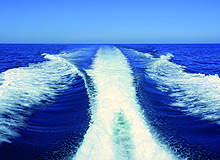
Fast, agile boats are becoming the number one option for coastguards, police forces, customs officials and other government organisations in a number of areas.
Besides protecting littoral boundaries and guarding borders, they can be used to prevent drug trafficking, to protect ports and shipping lanes, and as part of maritime salvage operations.
One country that is investing in this type of boat is India.
In 2010, its ministry of defence announced a tender for four fast interceptor craft – expected to have a top speed that exceeds 40kt – to improve the protection of its coastline.
It’s easy to see why the country might want such vessels for its navy when you consider that the terrorists that attacked Mumbai in 2008 travelled by sea.
But the appeal of such craft is wider than the rapid interception of suspicious vessels – many navies are considering these boats as an inexpensive all-round option.
Affordable yet capable
Navies across the world are facing budget cuts; others simply have less extensive ‘blue water’ ambitions compared to their neighbours. For these forces, small and high-tech boats represent a cheaper yet capable alternative. Bo Axelsson, president of boat manufacturer Swede Ship Marine, said that there was ‘a great interest’ in the company’s solutions because they accommodate complex equipment in a relatively small and fast platform.
Without giving any details, Axelsson confirmed that the company was in talks with customers for various vessels – some will be large and reconfigurable to various mission types, while others will be smaller and have top speeds exceeding 50kt.
His company has also contracted a new programme with the UAE Navy for 12 fast patrol vessels.
The design of these 26.5m-long boats will be based on the company’s 24m-long Ghannatha Class high-speed transport vessels. The first three boats will be constructed at Swede Ship Marine and the following nine at Abu Dhabi Shipbuilding as complete knock-down with material kits supplied by the company.
Seize the waves
Swede Ship Marine is not the only firm to benefit from burgeoning interest in faster vessels. Iraq is boosting its navy so that it can protect its oil platforms after the pullout of the US troops, a process that will see 15 patrol boats with a maximum speed of 30kt added to its fleet. The 35m-long vessels are being built by US-based Swiftships Shipbuilders. In 2010, the Trinidad and Tobago Coastguard received the last of six new high-speed patrol craft. The 30m-long aluminium boats, built by Australian company Austal, can travel at more than 40kt.
The Romanian Border Police have also received three Shaldag mk4 type fast patrol craft from Israel Shipyards. The boats, which can travel faster than 40kt, will be used in the Black Sea to fight illegal immigration and smuggling. Estonia’s Baltic Workboats has also completed the construction of the three WC 1500 patrol boats ordered by Azerbaijan’s State Customs Committee. The vessel can reach speeds of about 34kt.
Meanwhile, the US Navy is looking into ways of decreasing the cost of operating its riverine command boat. An experimental vessel has been demonstrated that runs on an alternative fuel – a 50:50 blend of algae-based fuel and Nato F-76 shipboard fuel. The 14.7m-long vessel can reach speeds of 40kt, and therefore provides the US Navy with a platform that it can use to effectively navigate challenging shallow waters.
Patrol boat refurbishment and refitting is also a growing market segment. In October 2010, Australian company DMS Maritime won a contract worth around $50m to support the 19 patrol boats used by the Pacific island nations.
It runs for five years, with an option to extend for a further 12.
This article was first published in our sister publication Defence & Security Systems International.




